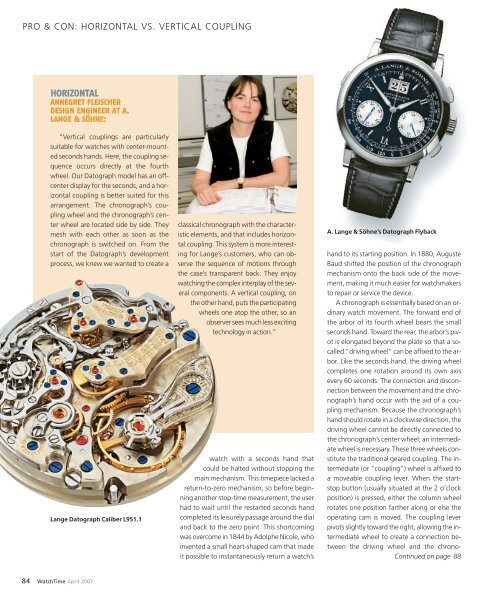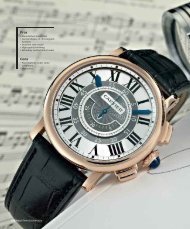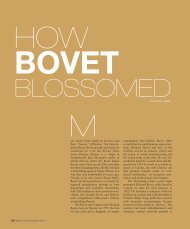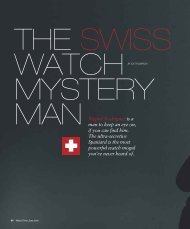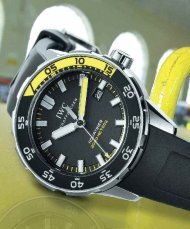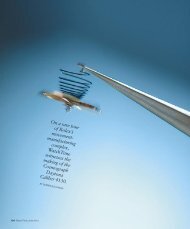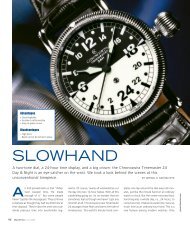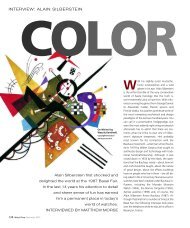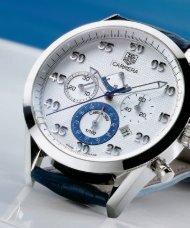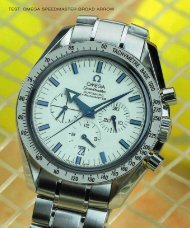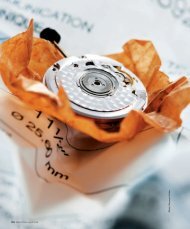pro & con: horizontal vs. vertical coupling - WatchTime
pro & con: horizontal vs. vertical coupling - WatchTime
pro & con: horizontal vs. vertical coupling - WatchTime
Create successful ePaper yourself
Turn your PDF publications into a flip-book with our unique Google optimized e-Paper software.
PRO & CON: HORIZONTAL VS. VERTICAL COUPLINGHORIZONTALANNEGRET FLEISCHERDESIGN ENGINEER AT A.LANGE & SÖHNE:“Vertical <strong>coupling</strong>s are particularlysuitable for watches with center-mountedse<strong>con</strong>ds hands. Here, the <strong>coupling</strong> sequenceoccurs directly at the fourthwheel. Our Datograph model has an offcenterdisplay for the se<strong>con</strong>ds, and a <strong>horizontal</strong><strong>coupling</strong> is better suited for thisarrangement. The chronograph’s <strong>coupling</strong>wheel and the chronograph’s centerwheel are located side by side. Theymesh with each other as soon as thechronograph is switched on. From thestart of the Datograph’s development<strong>pro</strong>cess, we knew we wanted to create aLange Datograph Caliber L951.1classical chronograph with the characteristicelements, and that includes <strong>horizontal</strong><strong>coupling</strong>. This system is more interestingfor Lange’s customers, who can observethe sequence of motions throughthe case’s transparent back. They enjoywatching the complex interplay of the severalcomponents. A <strong>vertical</strong> <strong>coupling</strong>, onthe other hand, puts the participatingwheels one atop the other, so anobserver sees much less excitingtechnology in action.”watch with a se<strong>con</strong>ds hand thatcould be halted without stopping themain mechanism. This timepiece lacked areturn-to-zero mechanism, so before beginninganother stop-time measurement, the userhad to wait until the restarted se<strong>con</strong>ds handcompleted its leisurely passage around the dialand back to the zero point. This shortcomingwas overcome in 1844 by Adolphe Nicole, whoinvented a small heart-shaped cam that madeit possible to instantaneously return a watch’sA. Lange & Söhne’s Datograph Flybackhand to its starting position. In 1880, AugusteBaud shifted the position of the chronographmechanism onto the back side of the movement,making it much easier for watchmakersto repair or service the device.A chronograph is essentially based on an ordinarywatch movement. The forward end ofthe arbor of its fourth wheel bears the smallse<strong>con</strong>ds hand. Toward the rear, the arbor’s pivotis elongated beyond the plate so that a socalled“driving wheel” can be affixed to the arbor.Like the se<strong>con</strong>ds hand, the driving wheelcompletes one rotation around its own axisevery 60 se<strong>con</strong>ds. The <strong>con</strong>nection and dis<strong>con</strong>nectionbetween the movement and the chronograph’shand occur with the aid of a <strong>coupling</strong>mechanism. Because the chronograph’shand should rotate in a clockwise direction, thedriving wheel cannot be directly <strong>con</strong>nected tothe chronograph’s center wheel; an intermediatewheel is necessary. These three wheels <strong>con</strong>stitutethe traditional geared <strong>coupling</strong>. The intermediate(or “<strong>coupling</strong>”) wheel is affixed toa moveable <strong>coupling</strong> lever. When the startstopbutton (usually situated at the 2 o’clockposition) is pressed, either the column wheelrotates one position farther along or else theoperating cam is moved. The <strong>coupling</strong> leverpivots slightly toward the right, allowing the intermediatewheel to create a <strong>con</strong>nection betweenthe driving wheel and the chrono-Continued on page 8884 <strong>WatchTime</strong> April 2007


